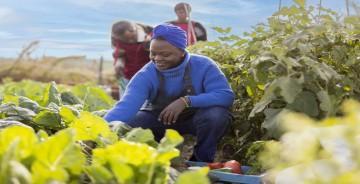
Current Efforts to Promote the Use of CAADP Biennial Review Data and Results for Evidence-Based Policymaking
The Comprehensive Africa Agriculture Development Programme Biennial Review: An innovative accountability and reporting tool
The Biennial Review (BR) process of the Comprehensive Africa Agriculture Development Programme (CAADP) has underscored the need to strengthen data systems and capacities and to promote evidence-based policymaking and decision-making. As part of the mutual accountability process, every two years, African Union (AU) member states compile and report data on over 300 data parameters to assess their progress toward achieving the Malabo Declaration’s agrifood system transformation goals by 2025. The country assessments are consolidated into a continental CAADP BR report that is presented during an AU Heads of State and Government Summit at the end of each BR cycle. After four cycles, the CAADP BR has generated not only the four continental reports, but also various working papers and briefs. In light of the low uptake of BR data and results, this post explores current efforts to promote the use of BR data and results.
Efforts to promote use of CAADP BR data and results
There are several ongoing efforts led by different BR stakeholders that are helping to promote the use of BR data and results. For example, researchers with the Regional Strategic Analysis and Knowledge Support System (ReSAKSS) work with BR focal points to draft and publish country and regional CAADP BR briefs that synthesize performance in the latest BR cycle, review policy changes due to the BR and highlight policy actions that should be taken to meet the Malabo Declaration goals by 2025. The briefs are disseminated and discussed during country and regional workshops organized either by ReSAKSS or by countries and regional economic communities (RECs). They are also shared with key stakeholders, like the CAADP Non-state Actor Group (CNG) and are discussed at major policy fora.
The CAADP electronic BR (eBR) was introduced in 2019 by the African Union Commission (AUC) in partnership with ReSAKSS to improve the efficiency of BR data entry, reporting and management. The web-based platform has helped to improve the quality of BR data and, thus, its reliability by reducing common data errors through data entry cell restrictions, flagging of outliers, unspecified units, inadvertent zeros and mandating data sources during data entry.
The CNG has played a pivotal role in promoting BR data use by developing its own BR toolkit for raising awareness and engagement on the CAADP BR among smallholder farmers, civil society organizations (CSO) and citizens. The group helps to simplify BR results to be more accessible to farmers and disseminates and discusses the results with policymakers and smallholder farmers alike. It also conducts advocacy campaigns that call for increased public investments in agriculture, and more recently has actively engaged elected parliamentarians in the BR process.
“Parliamentarians play a crucial role in reviewing government budgets and policies and yet for a long time, they were not aware of the BR,” said Ms. Constance Okeke, a project manager with ActionAid International and a member of CNG. “We have started organizing parliamentarian briefings at the country level and parliamentarian peer learning events at the regional level to discuss BR results with them so that they are well-informed to ask the executive branch the right questions and help effect change where progress is not being made,” she added.
Following the third BR report’s call for a strong communication and dissemination campaign at the country and regional levels, in partnership with its technical partners, AUC organized a workshop to sensitize national and regional BR experts, including CSO and members of the media, on the BR results. AUC has also developed CAADP BR toolkits that include a web-based, interactive platform that allows users to visualize the BR scores across all the reports and by Malabo commitment areas, countries and regions. However, the tool is limited as the results are displayed at an aggregate level and only scores are shown and not actual values that may help users scrutinize the performance.
Country governments and leading RECs also promote the use of BR data by organizing multistakeholder workshops in their respective countries and regions to disseminate and discuss the latest BR results. For example, to help promote BR data use in Kenya, “as soon as the BR report is out, we organize a stakeholder BR dissemination workshop that brings together representatives from several government line ministries, the private sector and other partners to go through the latest BR results, identify challenges and come up with an action plan for moving things forward,” said Ms. Josephine Ongosi, a principal agriculture officer in Kenya’s Ministry of Agriculture, Livestock, Fisheries and Cooperatives.
Assessments by ReSAKSS underscore the importance of efforts to promote the use of BR data by showing the potential for BR data to guide policymaking. The assessments, based on key informant interviews and online surveys, show that policy and programmatic changes have occurred in some countries in response to the countries using and internalizing results of the CAADP BR. For example, in response to low investment financing reported in BR reports, the governments of Cote d’Ivoire, Eswatini and Niger introduced initiatives and programs to promote private sector investments in agriculture and to spur agricultural productivity, while the government of Ghana increased public investment for several of its flagship crop and livestock programs (see Matchaya et al, 2022 and a previous Agrilinks post).
No Comments
Sorry, the comment form is closed at this time.